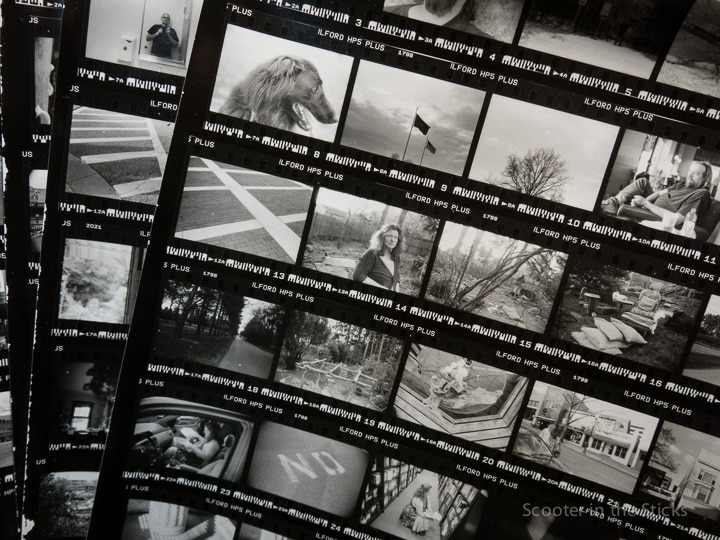 I have a small gray notebook to keep track of the black and white film I process. Entries include date, number of rolls, developer, temperature, developing time and notes on how the negatives look. Sometimes there may be a notation on the subject. Until now the last roll of film developed was in October 2011. That’s when the sink sprung a leak and how long it has taken me to make repairs. Obviously it doesn’t take that long to fix a sink. Life just got in the way.
I have a small gray notebook to keep track of the black and white film I process. Entries include date, number of rolls, developer, temperature, developing time and notes on how the negatives look. Sometimes there may be a notation on the subject. Until now the last roll of film developed was in October 2011. That’s when the sink sprung a leak and how long it has taken me to make repairs. Obviously it doesn’t take that long to fix a sink. Life just got in the way.
Slowly working through the backlog of exposed film and getting into the flow of processing — I had forgotten how satisfying the ritual dance in the darkroom can me, the low amber glow, the soft sound of water trickling through trays, the quiet disconnection from technology and distraction.
Such is the attraction of black and white film photography.
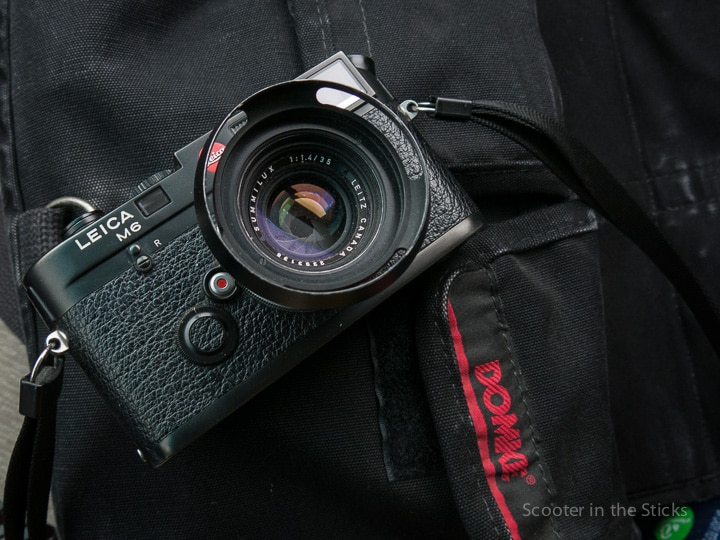 Using a film camera is a different experience than using a digital camera. I like to believe the image is all that matters but I know that’s not true. A body of work doesn’t spring into existence without a lot of work and sweat. The tools and processes involved not only affect the final product, but also the worker. For me, film has always resonated in my personal work. For the past couple years I’ve wandered away from it.
Using a film camera is a different experience than using a digital camera. I like to believe the image is all that matters but I know that’s not true. A body of work doesn’t spring into existence without a lot of work and sweat. The tools and processes involved not only affect the final product, but also the worker. For me, film has always resonated in my personal work. For the past couple years I’ve wandered away from it.
The Leica M6 has been a faithful companion for over a decade. It’s simple and reliable, much like the Vespa scooter I ride.
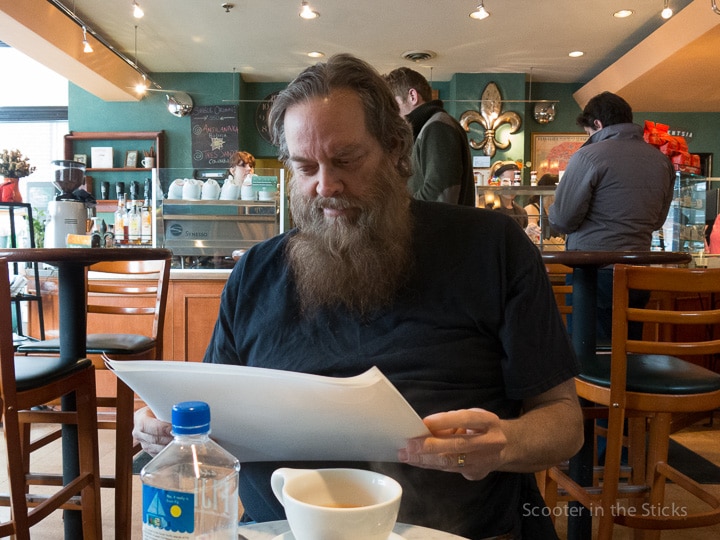 At Saint’s Cafe this morning Gordon looked over prints and contact sheets, a part of the long sharing we’ve engaged in to help motivate continued personal work. It’s easy to stop in favor of so many other things but I’m grateful that I’ve continued making photographs for myself for over 50 years. It just works.
At Saint’s Cafe this morning Gordon looked over prints and contact sheets, a part of the long sharing we’ve engaged in to help motivate continued personal work. It’s easy to stop in favor of so many other things but I’m grateful that I’ve continued making photographs for myself for over 50 years. It just works.
Below are the images I brought to the cafe.
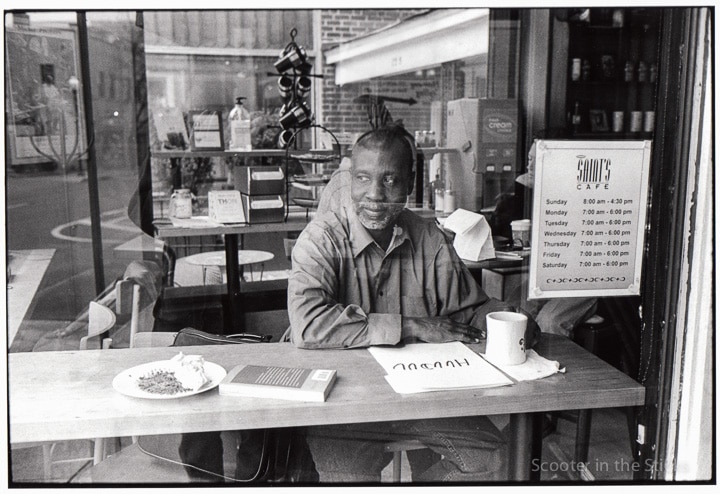 Carl is a Saint’s Cafe regular. I showed him the print and he did not recall me making the photo. I remember it well; standing outside the window waving to get his attention but he was lost in thought. Carl told me he must have been working on his Huuduu composition, a jazz-funk piece. He’s a musician and concert violinist.
Carl is a Saint’s Cafe regular. I showed him the print and he did not recall me making the photo. I remember it well; standing outside the window waving to get his attention but he was lost in thought. Carl told me he must have been working on his Huuduu composition, a jazz-funk piece. He’s a musician and concert violinist.
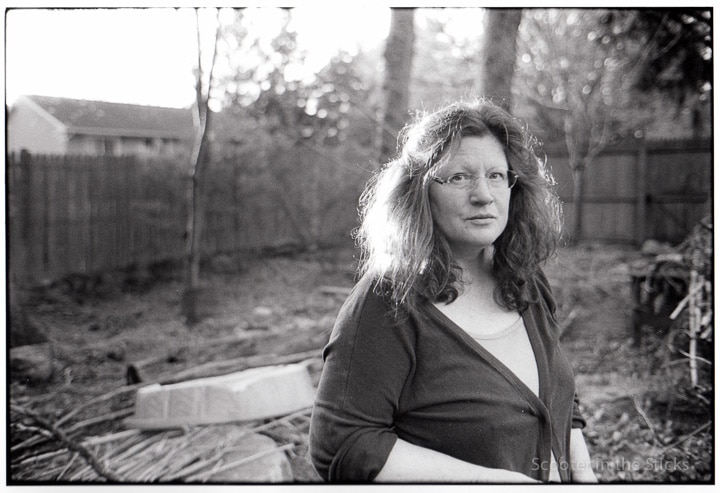 My friend and love, wife and confidant Kim in her garden. She sees everything.
My friend and love, wife and confidant Kim in her garden. She sees everything.
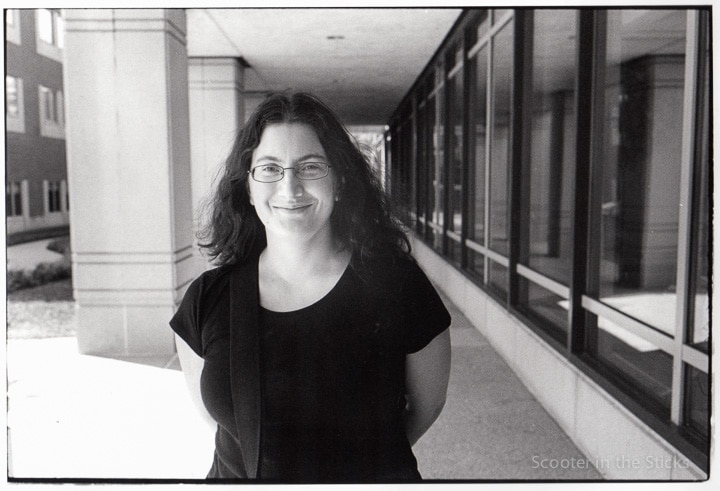 Aleta, the youngest child. She went with me to Baltimore at my last appointment at Johns Hopkins. I think she was smiling because afterwards we would pay a visit to IKEA where she would acquire some furniture.
Aleta, the youngest child. She went with me to Baltimore at my last appointment at Johns Hopkins. I think she was smiling because afterwards we would pay a visit to IKEA where she would acquire some furniture.
A lost part of photography. I had stopped taking photos in the early-80s when I had sold my camera and lenses before moving to Alaska. I kept the darkroom equipment with the intent of setting it back up but that never happened. All the stuff is still in the shed…
I remember repeatedly looking at the Leica cameras but could never justify it…
I bet there’s a lot of old photo and darkroom equipment in sheds across the country with thoughts of one day putting it to work.
With the arrival of eBay ownership of a Leica camera has become much more affordable. Lot’s of like new used cameras available for a fraction of their original cost. Prices less than the new higher end DSLR cameras. Sad to say though that prices for used Leica lenses have skyrocketed because people are mounting the on their micro 4/3 digital cameras. Once they realize they are so hot for that use I suspect prices will fall to a better place.
Ironically am in the process if ding likewise.
About nine months ago sold all of my Nikon gear, both digital (D700) and film (tired F100)
as well as my extensive and well-used prime and zoom lenses. Photography was not fun anymore and had not been so for many moons.
When you have some 35,000 slides in 600 slide strage boxes and half again colour and b&w negatives in three ring binders c/w contact sheets you have to ask yoursel why continue? Digital doeesn’t cut it for me and my images are for me.
Before Christmas last year was offered a box of screw mount Pentax cameras & lenses for free. Accepted the gift (the previous owner; has graduated to bayonet mount Pentax
for film and a point and shoot for digital.
So now the gear has been fowarded to a reliable person locally whorepars all things related to mechanical photographically. He keeps my Speed Graphic alive;
processing is done in batches by a lab in Toronto. All they do is process, I do the printing after scanning the negative and storing on a RAID system of three SSD’s of 500 mg each.
Out of the gifted box a Spotmatic II, an F three 59mm f/1.2 lenses and a 28mm lens of unknown vintage. All are being given a clean lube and an adjust as required.
One device for colour slide E-6, the other fror B&W and have all the required facilities to develop b&w here.
Have or shall we say, returning to my roots. My first good camera was a Pentax. a Leica would be nice. Problem here in Canada is finding a competent repar source is difficult.
I’ll stay with what I know.
The why continue question weighs heavily at times especially in the face of mountains of work already accomplished. The answer for each of us is different. A few nights ago I was listening to a podcast by Brooks Jensen, editor of Lenswork magazine, and he was talking about what to do with all the photos we collect over a lifetime and what’s going to happen to them when we die. His words hit me pretty hard — basically he was saying “give it all away” lest it all end up at the dump or at a garage sale after death. Unless you are one of the most elite photographers in the world, or have a six figure budget to endow a university archive to take your pictures, your heirs are going to struggle with the stuff. At least if you give photos to people who like them there is a chance the work will live on.
I’ve been thinking a lot about it.
My first 35mm camera was a Pentax. Loved it. I can still remember how it smelled. Not sure I could focus one now. The rangefinder in a Leica is indifferent to my vision but the old SLR viewfinders are a challenge.
Repairs on the Leica are getting more expensive than ever but there still are a handful of people working because there are so many collectors still wanting things serviced.
Wish you luck on your new photographic adventures Bryce!
Appointment at John Hopkins? Regular checkup I hope?
Yes, routine checkin with my rheumatologist. So far so good. Medication isn’t frying my liver, still works, and I still can move.
Oh my, FILM. I remember in high school making cartoon movies with a film wind-up movie camera and shooting two frames at a time. Once we made a friend ride a garbage can all over the school. I think it took more than two or three weeks of filming to get a 5-minute run of him riding the garbage can (2-frames at a time). I recently sold or gave away most of my camera collection because of the lack of film in the stores. I was purchasing my Black and White film from Amazon.
I surrendered to a Sony digital camera and it sure takes nice pictures but it seems too easy.
However, in my house I have hung on to the past by way of music. I have and still play two open reel tape decks with my tube amplifier and trusty Rega turntable. I still buy albums and do not have any CDs or MP3s to speak of. Lately I play my 1920s Columbia Grafonola. You can have a listen to Hot Dog Rag by Red Foley on my You Tube Channel at this link: http://youtu.be/iKgCzhpUga4 .
But in conclusion, I admire photographers like yourself who make every effort to keep film alive. Your pictures are always inspiring.
Peter,
My friends and I did the same thing with an old Keystone 8mm camera. Our setup was shooting pool and having all the balls go in on the break. Tedious work moving things and shooting the single frames.
All the film sources in town have gone away for black and white, same thing for paper and chemicals. I do all my shopping online now — either B&H Photo in New York, or FreeStyle Photo in California. Film and materials is still plentiful. And I believe film is cheaper in the long run because you aren’t replacing the camera nearly as often and generally don’t fall into the upgrade loop of camera, printer, software, computer, etc. which is really expensive.
Film isn’t dead yet for me. I suspect that I’ll continue as long as I can stumble down to the darkroom.
Man, you get a real workout winding up the Grafanola to listen to Red Foley!
It is satisying, and a bit ‘in your face’ to the modern times of digital everything. I also grew up shooting 35mm, starting with a Kodak Brownie Starmeter. My Dad taught me how to process & print b&w, and I went on to actually printing my own colour with the Cibachrome process. I do own a DSLR (Sony), which is excellent, but I never got rid of all my 35mm equipment. I was down to two P&S cameras, when I recently inherited an old Leica M3, with three lenses, and old Rolleiflex TLR and a subminiature. he TLR doesn’t work, but I did shoot a roll of B&W with the Leica on a recent trip to Tennessee over the holidays. I am expecting the results back this week. It is good to see there are some die-hards still out there. Keep up the good work – I verrily enjoy reading your Scooter in the Sticks posts (I once owned a Vespa 150, progressed through the years to a Yamaha Majesty 400 scoot, with a Buddy 150 in between. I now have a Piaggio MP3 250 – love it!)
I think there are a lot of people who have a background with cameras and film that wish the world was a bit different and they could still leave a roll of film at the drugstore to be processed. I always loved the anticipation as a kid waiting for that little yellow Kodak film bag. Even at the 1 hour photomat, same excitement.
I used to tell people that an MP3 was in my future somewhere when my strength and balance diminished but I still had the presence of mind to manage the locking front end. I really enjoyed riding the MP3.
It was always fun taking film shots but digital is much easier. Also you can take videos at the same time instead of carrying two cameras. As an art form print photography is truly special but sending photos shot minutes before to friends and family has its advantages.
Digital certainly has many advantages over film and I take advantage of them. But there are still some special places that for me film is the answer.
I continue to have the most unnatural looking smile in the world.
No, I’ve seen more unnatural smiles!